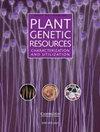Identification of high-oleic peanut chemical mutants and functional analysis of mutated FAD2B gene
IF 0.7
4区 生物学
Q3 PLANT SCIENCES
Plant Genetic Resources: Characterization and Utilization
Pub Date : 2022-05-04
DOI:10.1017/s1479262122000053
引用次数: 1
Abstract
It is generally accepted that high-oleic crops have at least 70% oleate. As compared to their normal-oleic counterparts, oil and food products made from high-oleic peanut have better keeping quality and are much healthier. Therefore, high-oleic peanut is well recognized by processors and consumers. However, owing to the limited availability of high-oleic donors, most present-day high-oleic peanut varietal releases merely have F435 type FAD2 mutations. Through screening of a mutagenized peanut population of 15L46, a high-yielding peanut line with desirable elliptical oblong large seeds, using near infrared model for predicting oleate content in individual single seeds, high-oleic peanut mutants were identified. Sequencing FAD2A and FAD2B of the mutants along with the wild type revealed that these mutants possessed G448A FAD2A (F435 type FAD2A mutation) and G558A FAD2B (non-F435 type FAD2B mutation). Expression of the wild and mutated type FAD2B in yeast verified that the functional mutation contributed to the high-oleic phenotype in these mutants. The mutants provided additional high-oleic donors to peanut quality improvement.高油花生化学突变体的鉴定及突变FAD2B基因的功能分析
人们普遍认为,高油酸作物至少含有70%的油酸。与普通含油花生相比,高含油花生制成的油和食品质量更好,更健康。因此,高油花生深受加工商和消费者的认可。然而,由于高油质供体的可用性有限,目前大多数高油质花生品种仅具有F435型FAD2突变。通过对具有理想椭圆形大种子的高产花生品系15L46诱变群体的筛选,利用近红外预测单粒种子中油酸含量的模型,鉴定出了高油酸花生突变体。对突变体FAD2A和FAD2B与野生型进行测序发现,这些突变体具有G448A FAD2A (F435型FAD2A突变)和G558A FAD2B(非F435型FAD2B突变)。野生型和突变型FAD2B在酵母中的表达证实了功能性突变促成了这些突变体的高油酸表型。这些突变体为花生品质改善提供了额外的高油供体。
本文章由计算机程序翻译,如有差异,请以英文原文为准。
求助全文
约1分钟内获得全文
求助全文
来源期刊

Plant Genetic Resources: Characterization and Utilization
Agricultural and Biological Sciences-Agronomy and Crop Science
CiteScore
2.80
自引率
0.00%
发文量
29
审稿时长
>12 weeks
期刊介绍:
Plant Genetic Resources is an international journal which provides a forum for describing the application of novel genomic technologies, as well as their integration with established techniques, towards the understanding of the genetic variation captured in both in situ and ex situ collections of crop and non-crop plants; and for the airing of wider issues relevant to plant germplasm conservation and utilisation. We particularly welcome multi-disciplinary approaches that incorporate both a technical and a socio-economic focus. Technical aspects can cover developments in technologies of potential or demonstrated relevance to the analysis of variation and diversity at the phenotypic and genotypic levels.
 求助内容:
求助内容: 应助结果提醒方式:
应助结果提醒方式:


